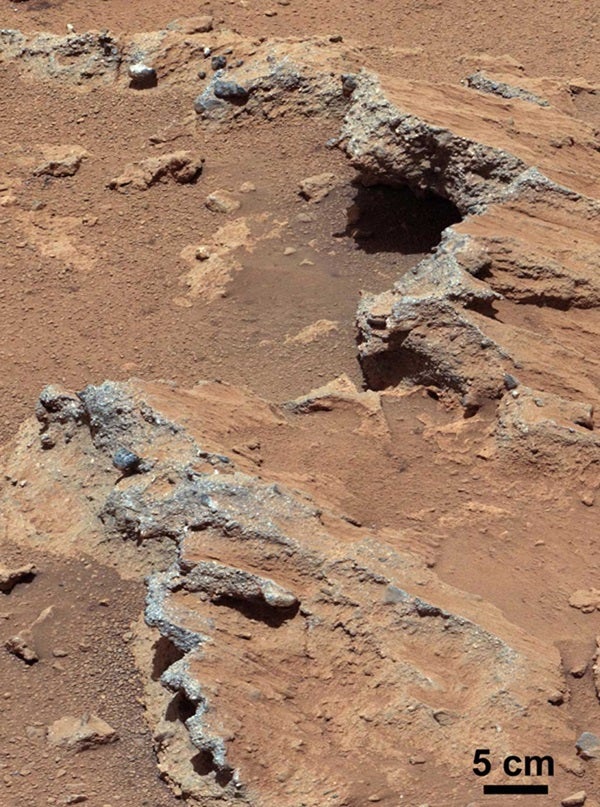The rocks are the first ever found on Mars that contain streambed gravels. The sizes and shapes of the gravels embedded in these conglomerate rocks — from the size of sand particles to the size of golf balls — enabled researchers to calculate the depth and speed of the water that once flowed at this location.
“We completed more rigorous quantification of the outcrops to characterize the size distribution and roundness of the pebbles and sand that make up these conglomerates,” said Rebecca Williams of the Planetary Science Institute in Tucson, Arizona. “We ended up with a calculation in the same range as our initial estimate last fall. At a minimum, the stream was flowing at a speed equivalent to a walking pace — a meter, or 3 feet, per second — and it was ankle-deep to hip-deep.”
Three pavement-like rocks examined with the telephoto capability of Curiosity’s Mast Camera (Mastcam) during the rover’s first 40 days on Mars are the basis for the new report. One, “Goulburn,” is immediately adjacent to the rover’s “Bradbury Landing” touchdown site. The other two, “Link” and “Hottah,” are about 165 and 330 feet (50 and 100 meters), respectively, to the southeast. Researchers also used the rover’s laser-shooting Chemistry and Camera (ChemCam) instrument to investigate the Link rock.
“These conglomerates look amazingly like streambed deposits on Earth,” Williams said. “Most people are familiar with rounded river pebbles. Maybe you’ve picked up a smoothed, round rock to skip across the water. Seeing something so familiar on another world is exciting and also gratifying.”
The larger pebbles are not distributed evenly in the conglomerate rocks. In Hottah, researchers detected alternating pebble-rich layers and sand layers. This is common in streambed deposits on Earth and provides additional evidence for stream flow on Mars. In addition, many of the pebbles are touching each other, a sign that they rolled along the bed of a stream.
“Our analysis of the amount of rounding of the pebbles provided further information,” said Sanjeev Gupta of Imperial College London. “The rounding indicates sustained flow. It occurs as pebbles hit each other multiple times. This wasn’t a one-off flow. It was sustained, certainly more than weeks or months, though we can’t say exactly how long.”
The stream carried the gravels at least a few miles, the researchers estimated.
The atmosphere of modern Mars is too thin to make a sustained stream flow of water possible, though the planet holds large quantities of water ice. Several types of evidence have indicated that ancient Mars had diverse environments with liquid water. However, none but these rocks found by Curiosity could provide the type of stream flow information published this week. Curiosity’s images of conglomerate rocks indicate that atmospheric conditions at Gale Crater once enabled the flow of liquid water on the martian surface.
During a two-year prime mission, researchers are using Curiosity’s 10 science instruments to assess the environmental history in Gale Crater on Mars, where the rover has found evidence of ancient environmental conditions favorable for microbial life.










